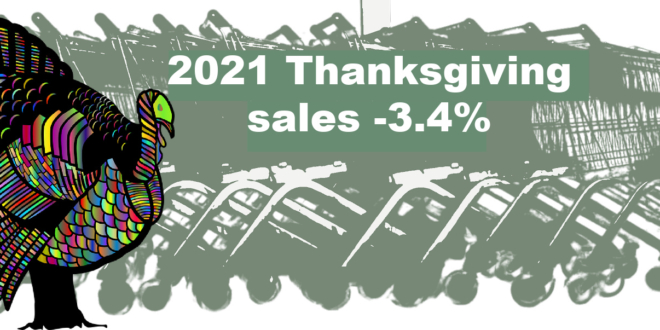By Jeff Domansky
With Black Friday sales over and the holiday shopping season well underway, let’s take a look at how merchants and the payments industry fared.
First, a sales overview from the retail industry’s National Retail Federation (NRF) and Adobe Analytics.
Overall sales decreased
The NRF reported more in-store shopper visits as consumers felt comfortable venturing out with masks or post-vaccination confidence while retailers accommodated the new shopping reality. An estimated 104.9 million consumers visited US retail outlets, up 13.7% from last year’s 92.3 million in-store visits.

Nearly half (49%) of consumers said they took advantage of early holiday sales before Thanksgiving, and 82% said deals were the same or better than last Thanksgiving.
Despite the positive spin by the NRF, Thanksgiving weekend shoppers spent an average of $301.27 on holiday-related purchases such as gifts, décor, apparel and toys. This is down 3.4% from $311.75 in 2020. As in previous years, most ($215.40) was spent directly on gifts.
Adobe estimated that in-store traffic was up 45.7% over 2020 but still down 23.8% from 2019. Walmart, Target and other retailers did close their stores on Thanksgiving Day this year.
Top gift purchases over the weekend included clothing and accessories (bought by 51% of those surveyed), toys (32%), gift cards/certificates (28%), books/music/movies/video games (27%) and electronics (24%).
“Retailers have adapted and enticed customers with several incentives throughout November. The Thanksgiving holiday weekend remains a significant time for friends and families to check specific holiday items off their lists,” said NRF President and CEO Matthew Shay. “Over the last few years, consumers have shifted their holiday shopping plans to start earlier in the season.”
According to the NRF, total in-store and online purchases were made by 179.8 million US consumers, down 3.5% from 186.4 million purchases in 2020. However, despite the drop, this was 21 million more than early predictions by the industry association.
Online sales slid slightly
Surprisingly, NRF data showed the overall number of online shoppers decreased by 13.8% to 127.8 million from 145.4 million shoppers last year.

For the first time, Adobe Analytics data showed a slight actual decrease of 1.4% to $10.4 billion in online sales on Cyber Monday. “Cyber Week (from Thanksgiving Day through Cyber Monday) sales totaled $33.9 billion in online spend, down 1.4% over 2020, as Black Friday dipped 1.3% at $8.9 billion vs $9 billion (2020) and Thanksgiving Day stayed flat at $5.1 billion,” it said in a news release.
On the positive side, Adobe said for the month of Nov 2021, e-commerce sales, including Cyber Monday, reached $109.8 billion, up 11.9% from last year.
“With early deals in October, consumers were not waiting around for discounts on big shopping days like Cyber Monday and Black Friday,” said Taylor Schreiner, director, Adobe Digital Insights. “This was further fueled by growing awareness of supply chain challenges and product availability. It spread out e-commerce spending across the months of October and November, putting us on track for a season that still will break online shopping records.”
Adobe predicts digital sales from Nov 1 through Dec 31 could reach $207 billion, a record gain of 10% over 2020.
NRF forecasts overall sales will grow between 8.5% and 10.5% over 2020 to between $843.4 billion and $859 billion by year-end. According to NRF’s annual survey released in October, consumers plan to spend $997.73 on gifts, holiday items and other non-gift purchases for themselves and their families this year.
Supply chain challenges growing

Supply chain challenges will likely remain a story during the 2021 holiday shopping season.
On Cyber Monday, Adobe found the prevalence of out-of-stock messages was up 8% compared to a week before (on Nov 22). During Nov 2021 (through Nov 29), the frequency of out-of-stock messages is up 169% vs pre-pandemic levels (Jan 2020) and up 258% vs two holiday seasons ago (Nov. 2019).
Adobe expects supply chain challenges to persist through to the end of the year and beyond.
TransUnion also found that in anticipation of supply chain issues and possible low inventory, 33% of consumers were shopping earlier this year.
Shoppers bought now, will pay later
As expected, buy now pay later (BNPL) sales jumped as a result of the lingering effect of Covid and the growing appeal of installment payments with no interest charges. Accenture reports overall US BNPL sales grew 230% over the past 12 months.
Afterpay saw a 34% increase in its own Black Friday week online and in-store BNPL orders this year.
“Between Black Friday and Cyber Monday, Afterpay found 11% more Gen Z consumers shopping year-over-year through its platform to purchase items. After a year of accelerated digital adoption, e-commerce is still maintaining a stronghold with a 30% increase year-over-year of Afterpay users spending online. Additionally, due to supply chain issues, a staggering 442% more shoppers are buying items in-stores year-over-year rather than waiting for online orders to arrive,” Afterpay said in a news release.

Overall, Afterpay merchants saw an 8% growth over 2020 as consumers chose installment payments for some of their Thanksgiving holiday shopping. Fashion retailers on Afterpay saw sales grow 26%, while fitness merchant sales jumped 46% over last year.
The appeal of BNPL to consumers is evident with its interest-free payments compared to credit cards. Accenture estimates consumers saved more than $459 million in credit card fees by purchasing with Afterpay in 2021.
The business case is equally strong for Afterpay merchants, who saw average order value grow 17% and an increase of 13% in new customers. Afterpay’s Shop Directory sends one million referrals globally to its merchants each day.
In the EU, analysis by Netherlands-based Mollie showed a 51% increase in BNPL purchases during the Thanksgiving shopping weekend. “Last year’s data hinted at the rapid growth of Buy Now, Pay Later methods for small and medium-sized m hard you come across are just checked your to check them out 2021 data shows strong, meaningful growth, driven by the flexibility and choice BNPL offers consumers,” said Ken Serdons, Chief Commercial Officer at Mollie.
“The majority of regions analyzed last year were under severe pandemic lockdown, yet restrictions have somewhat eased across Europe this year. With that shift, some may have expected shoppers to return to brick-and-mortar stores – but this is not the case, and consumer confidence in e-commerce has continued to grow. What is interesting is that Black Friday was out-performed by Cyber Monday and Cyber Week as a whole, suggesting it’s become less about a single day and more about a shopping week,” Serdons added.
Black Friday fraud grew too
One disquieting fact emerged during the Thanksgiving shopping extravaganza. Fraudsters had a field day.

TransUnion estimated fraud attempts were up 25% globally compared to 15.7% observed earlier in 2021. Fortunately, fraudulent online transaction attempts in the US were comparable to last year at 19.7%.
“The holiday shopping season is a popular time for bad actors to engage in fraudulent activity, particularly in the e-commerce and retail industry,” said Shai Cohen, senior vice president of global fraud solutions at TransUnion. “Online shopping is the new norm for most consumers, and that trend has been further accelerated due to the COVID-19 pandemic.
With consumers shopping earlier and conducting some of their shopping online, TransUnion’s analysis found that Saturday, Nov 27, had the highest suspected number of digital fraud attempts at 22% in the US.
All in all, Thanksgiving weekend shopping is encouraging for retailers if they can navigate the volatile combination of competitive, supply chain, fraud, and Covid challenges.
Related PaymentsNEXT news:
Financial fraud ramps up as holiday shopping season looms
Just another $10.8 billion sales record for Cyber Monday








LET’S CONNECT